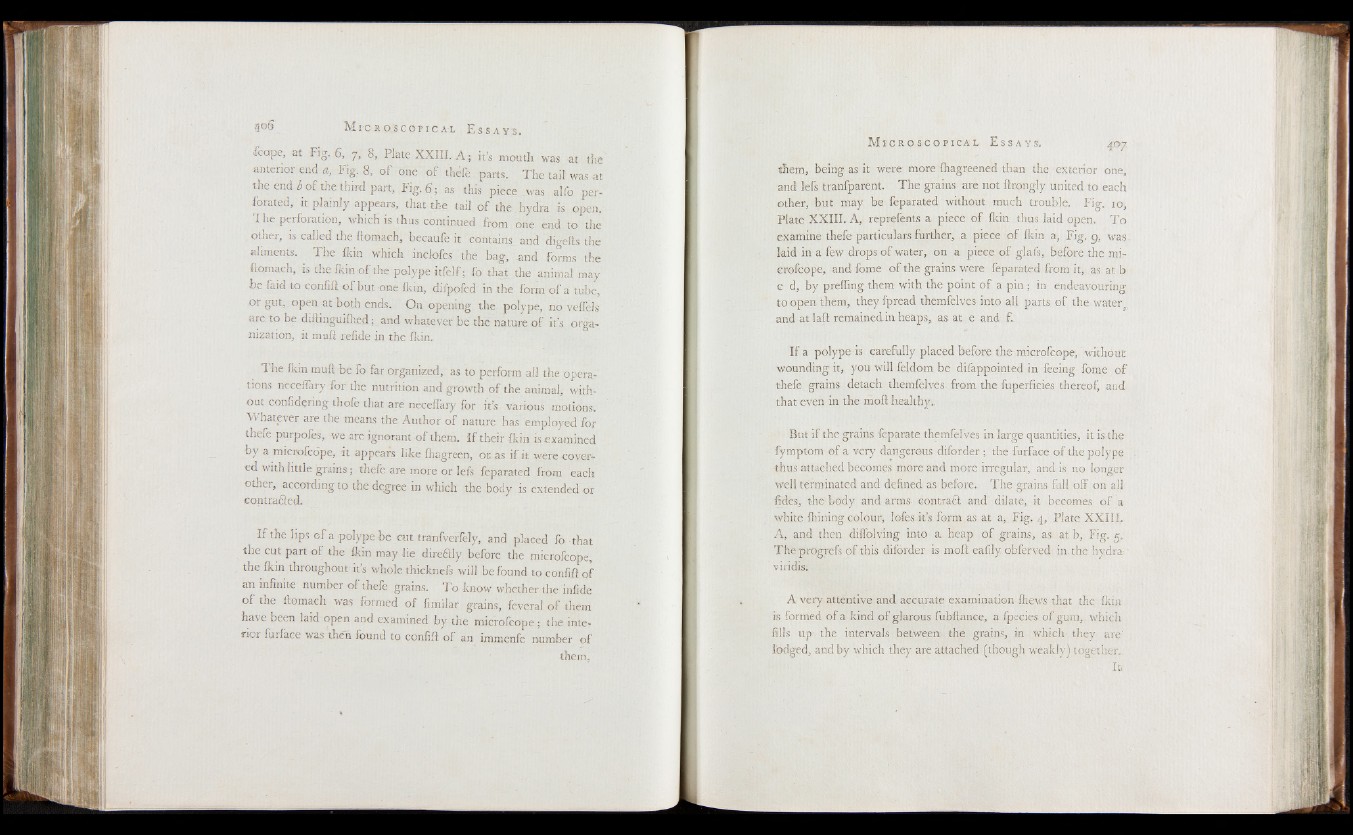
,
goS M i c r o s c o p i c a l E s s ,
fcape, at Fig. 6, 7, 8, Plate XXIII. A ; it’s mouth was at the
anterior end a, Fig. 8, o f one o f thefe parts. The tail was at
the end b of the third part, Fig. 6; as this piece was alfo perforated,
it plainly appears, that the tail o f the hydra is open.
The perforation, which is thus continued from one end to the
other, is called the ftomach, becaufe it contains and digefls the
aliments. The ildn which inclofes the bag, and forms the
ftomach, is the flan o f the polype itfelf; fo that the animal may
be faid to confift o f but one fldn, difpofed in the form o f a tube,
or gut, open at both ends. On opening the polype, no veffels
are to be diftinguifhed; and whatever be the nature o f it’s organization,
it muft relide in the fkin.
The fldn muft be fo far organized, as to perform all the operations
neceffary for the nutrition and growth of the animal, without
confidering thofe that are neceffary for it’s Various motions.
Whatever are the means the Author of nature has employed for
thefe purpofes, we are ignorant o f them. I f their fkin is examined
by a microfcope, it appears like fhagreen, or as if it were covered
with little grains; thefe are more or lefs feparated from each
other, according to the degree in which the body is extended or
contraSed.
I f the bps o f a polype be cut tranfverfely, and placed fo that
the cut part of the fldn may lie directly before the microfcope,
the fldn throughout it’s whole thicknefs will be found to confift of
an infinite number of thefe grains. To know whether the infide
o f the ftomach was formed of fimilar grains, feveral o f them
have been laid open and examined by the microfcope ; the inter
rior furface was then found to confift o f an immenfe number of
them.
i 111
them, being as it were more fhagreened than the exterior one,
and lefs tranfparent. The grains are not ftrongly united to each
other, but may be feparated without much trouble. Fig, io,
Plate XXIII. A, reprefents a piece of fkin thus laid open. T o
examine thefe particulars further, a piece o f fldn a, Fig. g, was
laid in a few drops of water, on a piece o f glafs, before the mi-
erofcope, and feme of the grains were feparated from it, as at b
c d, by preffmg them with the point of a pin ; in endeavouring
to open them, they fpread themfelves into all parts of the water,,
and at laft remainedin heaps, as at e and £.
I f a polype-is carefully placed before the-microfcope, without
wounding it, you will feldom be difappointed in feeing feme of
thefe grains detach themfelves from the fuperficies thereof, and
that even in the moft healthy.
But if the grains feparate themfelves in large quantities, it is the
fymptom o f a very dangerous diforder ; the furface of the polype
thus attached becomes more and more irregular, and is no longer
well terminated and defined as before. The grains fall off on all
fides, the body and arms- oontraft and dilate, it becomes o f a
white fhining colour, lofes it’s form as at a, Fig. a, Plate XXIII.
A, and then diffolving into a heap o f grains, as at b, Fig. 5.
The progrefs of this diforder is moft eafily obferved in. the hydra
viridis;
A very attentive and accurate examination Ihews that the fkin
is formed of a kind o f glarous fubftance, a fpecies of gum, which
fills up- the intervals between the grains, in which they are:
lodged, and by which they are attached (though weakly) together,.
It